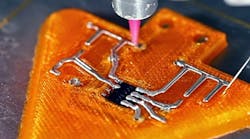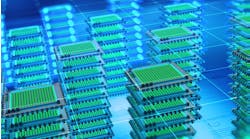2015 began with a review of what the writers of Back to the Future II imagined present day to be like. Now that we are a few days into the year, it's safe to say that there are no hoverboards or self-lacing Nikes. The writers had a hard enough time envisioning life fifteen years in the future. Today, with the advent of 3D printers, it is harder still.
One groundbreaking printer, the Voxel8, made its debut at the Consumer Electronics Show in Las Vegas this year. The Voxel8 is unique because it is the first 3D electronics printer. The printer can print both plastic and conductive material. This allows the circuitry, and the physical structure of an object to be printed simultaneously. The creators have partnered with Autodesk to include a library of electronic component models. The groundbreaking technology is the ink used in the printer. The ink is made of silver particles and has a resistivity of <5.00x10-7 Ω-m. Unlike solder, the ink can be applied at room temperature and only takes a few minutes to completely dry.
What does 3D electronic printing mean for the supply side of the electronic components industry?
First, the Voxel8 offers several advantages. The circuit boards can assume different shapes, including curved boards. A second advantage is speed. With traditional methods, it can take up to several days to build a prototype, but with the printer, a model can be produced within one hour.
While it may not happen instantaneously, professionals who work with the supply-side of electronic components may soon see a shift in their roles. Instead of sourcing components, there will soon be a market for standard circuit board blueprints.
Jennifer A. Lewis, head of the team, sums this up. "Rather than shipping components, you are going to be shipping CAD (computer-aided design) files and then you’re going to have local centers of manufacturing excellence, where these CAD files are just ported and then directly products come out."
A YouTube video, which portrays the 3d printer team, showcases a drone that's been printed using the Voxel8. The motor and propellers had to be attached manually, but everything else was done by the printer.
The first models are due to be shipped out at the end of the year. The models are not cheap. Priced at $10,000, they are aimed at industry professionals. The team also has other goals in mind. The team members have already created an ink that can print lithium-ion batteries, but they are not limiting themselves to the electronics industry. The next step is look at producing (or printing) human tissue in order to create or replace human organs.
References: Relevant articles in www.wired.com and www.xconomy.com were used as reference.
Image Credits: http://diy3dprinting.blogspot.com/









